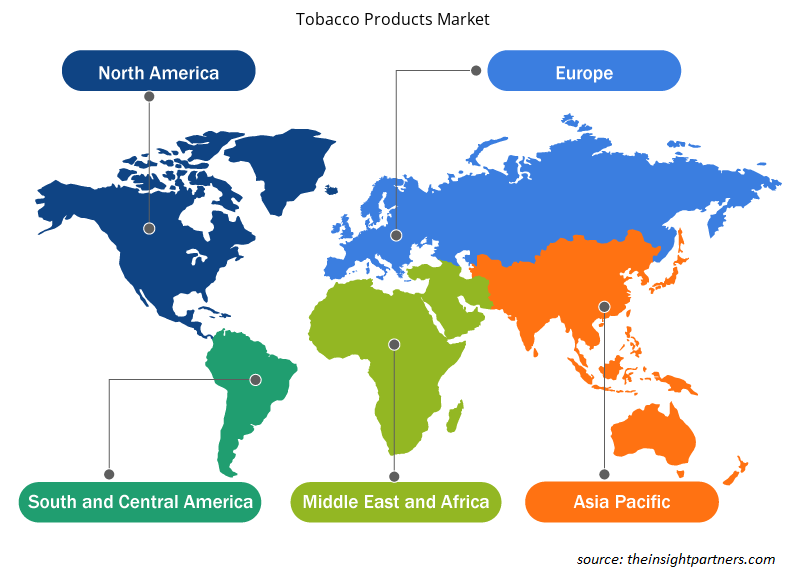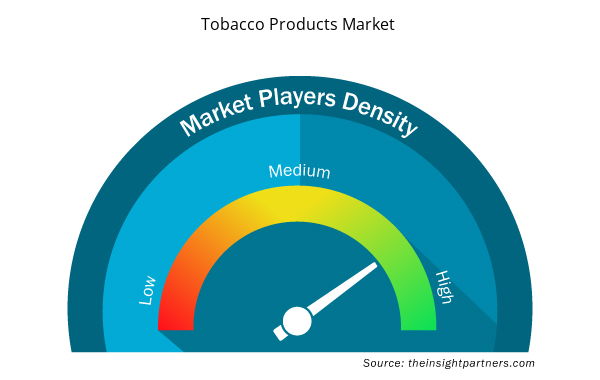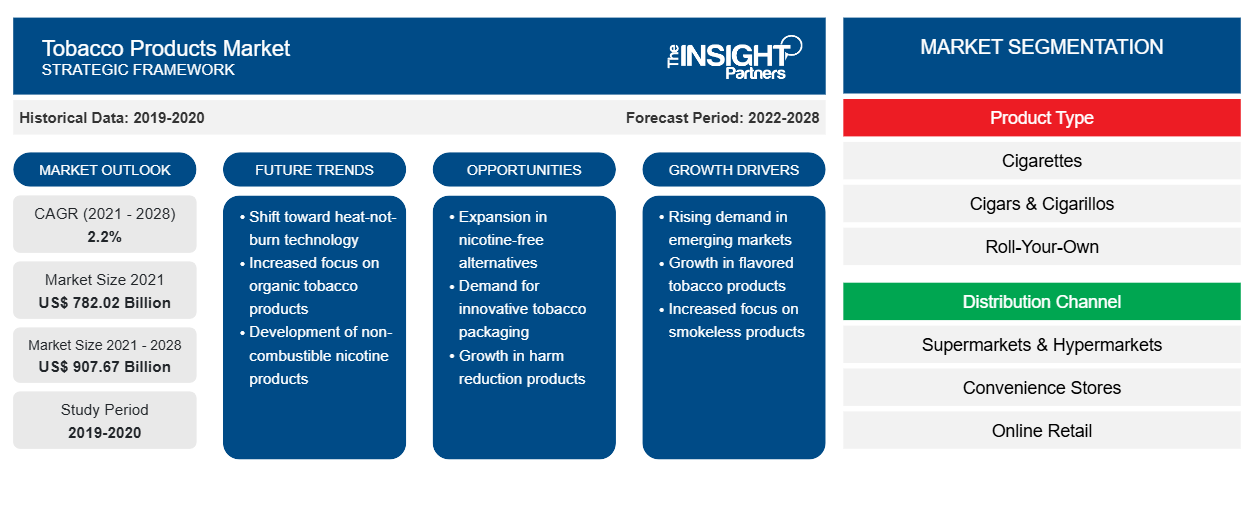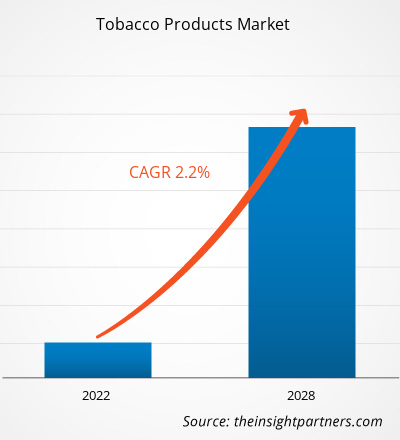Se proyecta que el mercado de productos de tabaco alcance los 907.665,43 millones de dólares estadounidenses en 2028, frente a los 782.022,19 millones de dólares estadounidenses en 2021. Se espera que crezca a una CAGR del 2,2 % entre 2021 y 2028.
Las hojas de tabaco de distintas variedades, como Virginia y Burley, se mezclan para fabricar productos como cigarrillos , puros y cigarrillos, y tabaco para liar. El consumo de tabaco y productos relacionados aumentó en todo el mundo durante la época de desaceleración económica debido a la caída de los mercados bursátiles y las ejecuciones hipotecarias, y al estrés relacionado con los despidos, que impulsaron a muchas personas a buscar refugio en el tabaco. El tabaco es una de las sustancias adictivas más comunes en el mundo. También contribuye a la mayoría de los ingresos fiscales de varias naciones en economías desarrolladas y en desarrollo.
En 2020 , la región de Asia y el Pacífico tuvo la mayor participación en el mercado de productos de tabaco , mientras que se espera que Oriente Medio y África registren una CAGR significativa en el mercado durante el período de pronóstico. Los actores clave que operan en el mercado de productos de tabaco están expandiendo sus operaciones en Oriente Medio y África debido a la base de clientes potenciales, las leyes favorables y el panorama minorista en rápido desarrollo en toda la región.
Personalice este informe según sus necesidades
Obtendrá personalización en cualquier informe, sin cargo, incluidas partes de este informe o análisis a nivel de país, paquete de datos de Excel, así como también grandes ofertas y descuentos para empresas emergentes y universidades.
- Obtenga las principales tendencias clave del mercado de este informe.Esta muestra GRATUITA incluirá análisis de datos, desde tendencias del mercado hasta estimaciones y pronósticos.
Impacto de la pandemia de COVID-19 en el mercado de productos de tabaco
La pandemia de COVID-19 planteó desafíos sin precedentes para muchos sectores a principios de 2020. Los confinamientos, las restricciones fronterizas, las prohibiciones de viaje, la interrupción de la fabricación y otras medidas de seguridad implementadas por los gobiernos según las directrices de la OMS y los ministerios de salud nacionales obstaculizaron las operaciones de fabricación. Por otro lado, según estudios realizados por el Colegio Americano de Médicos, durante los primeros 16 meses de la pandemia de COVID-19, las ventas de cigarrillos en los EE. UU. fueron mayores de lo previsto. La mayoría de las empresas tabacaleras fueron testigos de un aumento en la demanda de productos de tabaco sin humo o calentados y productos de tabaco para masticar durante la pandemia. Sin embargo, se enfrentaron a una ligera disminución en las ventas minoristas de viajes debido a las prohibiciones de viaje.
Perspectivas del mercado
La creciente demanda de productos de tabaco no combustibles impulsa el crecimiento del mercado
Debido a las crecientes preocupaciones sanitarias relacionadas con el consumo de productos de tabaco combustibles, los gobiernos han alentado a las empresas a introducir varias leyes y regulaciones para controlar el consumo de tabaco. Han aumentado los impuestos sobre el tabaco combustible y reducido los precios del tabaco no combustible. Esto resultó en una mayor aceptación de productos no combustibles, como los cigarrillos electrónicos. Por ejemplo, el gobierno del Reino Unido adoptó un enfoque holístico al aumentar significativamente los impuestos sobre los productos de tabaco combustibles y reducir los impuestos sobre los productos no combustibles. Esto aumentó la adopción de cigarrillos electrónicos en el mercado del Reino Unido, reduciendo significativamente las tasas de prevalencia del tabaquismo en el país. Los fabricantes también han desarrollado productos de tabaco orales, no combustibles o sin humo dentro de la categoría de productos de riesgo reducido (RRP).RRPs) category.
Información sobre el tipo de producto
Según el tipo de producto, el mercado de productos de tabaco se segmenta en cigarrillos, puros y cigarrillos, tabaco para liar y otros. Se prevé que el segmento de otros productos de tabaco registre la CAGR más alta durante el período de pronóstico. Este segmento incluye cigarrillos electrónicos, vaporizadores, snus y productos solubles. La creciente conciencia sobre el daño causado por los productos de tabaco combustibles está impulsando la demanda de productos de tabaco no combustibles, como cigarrillos electrónicos, vaporizadores y productos de tabaco para masticar.
Información sobre el canal de distribución
Según el canal de distribución, el mercado de productos de tabaco se ha segmentado en supermercados e hipermercados, tiendas de conveniencia, venta minorista en línea y otros. Se proyecta que el segmento de venta minorista en línea registre la CAGR más alta del mercado durante el período de pronóstico. La venta minorista en línea ofrece una experiencia de compra conveniente para los usuarios, seguida de una entrega de productos simplificada. Las tiendas minoristas en línea ofrecen una amplia gama de productos con grandes descuentos; además, los consumidores pueden comprar cómodamente los productos deseados de forma remota. Los servicios de entrega a domicilio alientan a una gran cantidad de consumidores a comprar a través de portales de comercio electrónico.
Los actores clave que operan en el mercado de productos de tabaco incluyen Altria Group, Inc.; British American Tobacco plc; Swedish Match AB; ITC Ltd.; Japan Tobacco International; Imperial Brands; Philip Morris Products SA; Vector Group LTD.; Pyxus International, Inc.; y China Tobacco International (HK) Company Limited. Estos actores se dedican al desarrollo de productos con riesgos reducidos para la salud para satisfacer las tendencias emergentes de los consumidores, además de cumplir con los marcos regulatorios. Están involucrados en fusiones y adquisiciones, expansiones comerciales y asociaciones para expandir su participación de mercado.
Perspectivas regionales del mercado de productos de tabaco
Los analistas de Insight Partners explicaron en detalle las tendencias y los factores regionales que influyen en el mercado de productos de tabaco durante el período de pronóstico. Esta sección también analiza los segmentos y la geografía del mercado de productos de tabaco en América del Norte, Europa, Asia Pacífico, Oriente Medio y África, y América del Sur y Central.

- Obtenga datos regionales específicos para el mercado de productos de tabaco
Alcance del informe sobre el mercado de productos de tabaco
| Atributo del informe | Detalles |
|---|---|
| Tamaño del mercado en 2021 | US$ 782.02 mil millones |
| Tamaño del mercado en 2028 | US$ 907,67 mil millones |
| CAGR global (2021-2028) | 2,2% |
| Datos históricos | 2019-2020 |
| Período de pronóstico | 2022-2028 |
| Segmentos cubiertos | Por tipo de producto
|
| Regiones y países cubiertos | América del norte
|
| Líderes del mercado y perfiles de empresas clave |
|
Densidad de actores del mercado de productos de tabaco: comprensión de su impacto en la dinámica empresarial
El mercado de productos de tabaco está creciendo rápidamente, impulsado por la creciente demanda de los usuarios finales debido a factores como la evolución de las preferencias de los consumidores, los avances tecnológicos y una mayor conciencia de los beneficios del producto. A medida que aumenta la demanda, las empresas amplían sus ofertas, innovan para satisfacer las necesidades de los consumidores y aprovechan las tendencias emergentes, lo que impulsa aún más el crecimiento del mercado.
La densidad de actores del mercado se refiere a la distribución de las empresas o firmas que operan dentro de un mercado o industria en particular. Indica cuántos competidores (actores del mercado) están presentes en un espacio de mercado determinado en relación con su tamaño o valor total de mercado.
Las principales empresas que operan en el mercado de productos de tabaco son:
- Grupo Altria, Inc.
- Tabaco americano británico plc.
- Partido sueco AB
- Compañía: ITC Ltd.
- Tabaco japonés internacional
Descargo de responsabilidad : Las empresas enumeradas anteriormente no están clasificadas en ningún orden particular.

- Obtenga una descripción general de los principales actores clave del mercado de productos de tabaco
Informe Destacado
- Tendencias progresivas de la industria en el mercado de productos de tabaco para ayudar a los actores a desarrollar estrategias efectivas a largo plazo
- Estrategias de crecimiento empresarial adoptadas para asegurar el crecimiento en mercados desarrollados y en desarrollo
- Análisis cuantitativo del mercado de productos de tabaco de 2019 a 2028
- Estimación de la demanda mundial de productos de tabaco
- Análisis de las cinco fuerzas de Porter para ilustrar la eficacia de los compradores y proveedores que operan en la industria
- Avances recientes para comprender el escenario competitivo del mercado
- Tendencias y perspectivas del mercado, así como factores que rigen el crecimiento del mercado de productos de tabaco
- Asistencia en el proceso de toma de decisiones destacando las estrategias de mercado que sustentan el interés comercial, lo que conduce al crecimiento del mercado.
- Tamaño del mercado de productos de tabaco en varios nodos
- Descripción detallada y segmentación del mercado y la dinámica de la industria tabacalera
- Tamaño del crecimiento en varias regiones con oportunidades de crecimiento prometedoras
- Análisis histórico (2 años), año base, pronóstico (7 años) con CAGR
- Análisis PEST y FODA
- Tamaño del mercado Valor/volumen: global, regional, nacional
- Industria y panorama competitivo
- Conjunto de datos de Excel



Report Coverage
Revenue forecast, Company Analysis, Industry landscape, Growth factors, and Trends

Segment Covered
This text is related
to segments covered.

Regional Scope
North America, Europe, Asia Pacific, Middle East & Africa, South & Central America

Country Scope
This text is related
to country scope.
Preguntas frecuentes
The global tobacco products market is primarily driven by the rising consumption of tobacco products in developing regions such as Asia-Pacific and the Middle East & Africa.
Based on product type, the other tobacco products segment is projected to grow at the fastest CAGR. Other tobacco products include e-cigarettes & vapes, snus, dissolvable, among others. The growing awareness about the hazardous effects of smoking among consumers is driving the demand for e-cigarettes, vapes, and snus.
Based on distribution channel, the supermarkets and hypermarkets segment held the largest market share owing to high customer traffic in these stores coupled with availability of different brands of tobacco products under one roof.
In 2020, Asia-Pacific led the global tobacco products market owing to the rising number of tobacco consumers across India, China, Japan, among other countries, changing lifestyles of people, increasing disposable income level, and easy available of different brands of tobacco products in the region
The tobacco products market is highly regulated. The manufacturers of tobacco products have to comply with stringent packaging and labeling regulations set by various regulatory bodies across different countries. Moreover, there are few yet dominant market players having strong distribution network and well-established customer base. Further, governments of different nations impose high duties on tobacco products to minimize their consumption. These are some of the entry barriers in the market.
Some of the prominent players operating in the global tobacco products market include Altria Group, Inc.; British American Tobacco plc; Swedish Match AB; ITC Ltd.; Japan Tobacco International; Imperial Brands; Philip Morris Products S.A.; Vector Group LTD.; Pyxus International, Inc.; and China Tobacco International (HK) Company Limited.
Trends and growth analysis reports related to Consumer Goods : READ MORE..
The List of Companies - Tobacco Products Market
- Altria Group, Inc.
- British American Tobacco plc.
- Swedish Match AB
- ITC Ltd.
- Japan Tobacco International
- Imperial Brands
- Philip Morris Products S.A.
- Vector Group LTD.
- Pyxus International, Inc.
- China Tobacco International (HK) Company Limited
The Insight Partners performs research in 4 major stages: Data Collection & Secondary Research, Primary Research, Data Analysis and Data Triangulation & Final Review.
- Data Collection and Secondary Research:
As a market research and consulting firm operating from a decade, we have published and advised several client across the globe. First step for any study will start with an assessment of currently available data and insights from existing reports. Further, historical and current market information is collected from Investor Presentations, Annual Reports, SEC Filings, etc., and other information related to company’s performance and market positioning are gathered from Paid Databases (Factiva, Hoovers, and Reuters) and various other publications available in public domain.
Several associations trade associates, technical forums, institutes, societies and organization are accessed to gain technical as well as market related insights through their publications such as research papers, blogs and press releases related to the studies are referred to get cues about the market. Further, white papers, journals, magazines, and other news articles published in last 3 years are scrutinized and analyzed to understand the current market trends.
- Primary Research:
The primarily interview analysis comprise of data obtained from industry participants interview and answers to survey questions gathered by in-house primary team.
For primary research, interviews are conducted with industry experts/CEOs/Marketing Managers/VPs/Subject Matter Experts from both demand and supply side to get a 360-degree view of the market. The primary team conducts several interviews based on the complexity of the markets to understand the various market trends and dynamics which makes research more credible and precise.
A typical research interview fulfils the following functions:
- Provides first-hand information on the market size, market trends, growth trends, competitive landscape, and outlook
- Validates and strengthens in-house secondary research findings
- Develops the analysis team’s expertise and market understanding
Primary research involves email interactions and telephone interviews for each market, category, segment, and sub-segment across geographies. The participants who typically take part in such a process include, but are not limited to:
- Industry participants: VPs, business development managers, market intelligence managers and national sales managers
- Outside experts: Valuation experts, research analysts and key opinion leaders specializing in the electronics and semiconductor industry.
Below is the breakup of our primary respondents by company, designation, and region:

Once we receive the confirmation from primary research sources or primary respondents, we finalize the base year market estimation and forecast the data as per the macroeconomic and microeconomic factors assessed during data collection.
- Data Analysis:
Once data is validated through both secondary as well as primary respondents, we finalize the market estimations by hypothesis formulation and factor analysis at regional and country level.
- Macro-Economic Factor Analysis:
We analyse macroeconomic indicators such the gross domestic product (GDP), increase in the demand for goods and services across industries, technological advancement, regional economic growth, governmental policies, the influence of COVID-19, PEST analysis, and other aspects. This analysis aids in setting benchmarks for various nations/regions and approximating market splits. Additionally, the general trend of the aforementioned components aid in determining the market's development possibilities.
- Country Level Data:
Various factors that are especially aligned to the country are taken into account to determine the market size for a certain area and country, including the presence of vendors, such as headquarters and offices, the country's GDP, demand patterns, and industry growth. To comprehend the market dynamics for the nation, a number of growth variables, inhibitors, application areas, and current market trends are researched. The aforementioned elements aid in determining the country's overall market's growth potential.
- Company Profile:
The “Table of Contents” is formulated by listing and analyzing more than 25 - 30 companies operating in the market ecosystem across geographies. However, we profile only 10 companies as a standard practice in our syndicate reports. These 10 companies comprise leading, emerging, and regional players. Nonetheless, our analysis is not restricted to the 10 listed companies, we also analyze other companies present in the market to develop a holistic view and understand the prevailing trends. The “Company Profiles” section in the report covers key facts, business description, products & services, financial information, SWOT analysis, and key developments. The financial information presented is extracted from the annual reports and official documents of the publicly listed companies. Upon collecting the information for the sections of respective companies, we verify them via various primary sources and then compile the data in respective company profiles. The company level information helps us in deriving the base number as well as in forecasting the market size.
- Developing Base Number:
Aggregation of sales statistics (2020-2022) and macro-economic factor, and other secondary and primary research insights are utilized to arrive at base number and related market shares for 2022. The data gaps are identified in this step and relevant market data is analyzed, collected from paid primary interviews or databases. On finalizing the base year market size, forecasts are developed on the basis of macro-economic, industry and market growth factors and company level analysis.
- Data Triangulation and Final Review:
The market findings and base year market size calculations are validated from supply as well as demand side. Demand side validations are based on macro-economic factor analysis and benchmarks for respective regions and countries. In case of supply side validations, revenues of major companies are estimated (in case not available) based on industry benchmark, approximate number of employees, product portfolio, and primary interviews revenues are gathered. Further revenue from target product/service segment is assessed to avoid overshooting of market statistics. In case of heavy deviations between supply and demand side values, all thes steps are repeated to achieve synchronization.
We follow an iterative model, wherein we share our research findings with Subject Matter Experts (SME’s) and Key Opinion Leaders (KOLs) until consensus view of the market is not formulated – this model negates any drastic deviation in the opinions of experts. Only validated and universally acceptable research findings are quoted in our reports.
We have important check points that we use to validate our research findings – which we call – data triangulation, where we validate the information, we generate from secondary sources with primary interviews and then we re-validate with our internal data bases and Subject matter experts. This comprehensive model enables us to deliver high quality, reliable data in shortest possible time.


 Obtenga una muestra gratuita de este informe
Obtenga una muestra gratuita de este informe